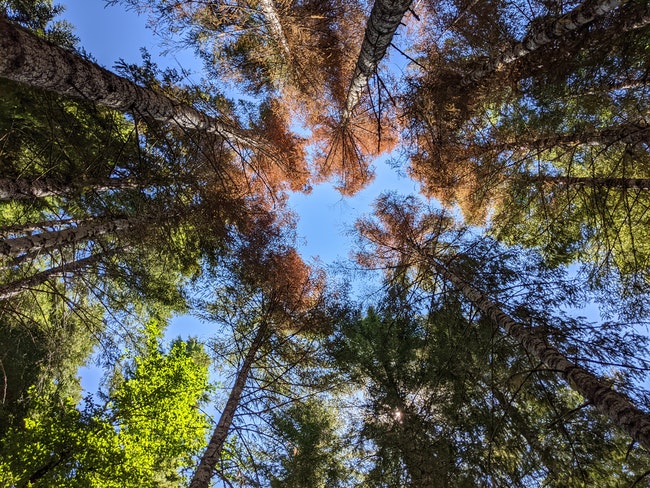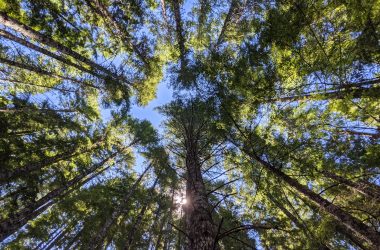 These trees experienced such high temperatures as flames burned beneath them that their needles died. The torched trees may pose a future fire hazard. Game Hog Creek Fire, July 22 2021, Photo: Chas Hundley
These trees experienced such high temperatures as flames burned beneath them that their needles died. The torched trees may pose a future fire hazard. Game Hog Creek Fire, July 22 2021, Photo: Chas Hundley
Parked across Idiot Creek Road on Thursday, July 22, Oregon Department of Forestry’s Terry Hudnall was the first indication that a wildfire still smoldered just west of the Coast Range summit in the Tillamook State Forest.
Hudnall, providing traffic control at the Drift Creek and Idiot Creek Road junction at the Game Hog Creek Fire, is usually a mechanic at the Forest Grove District for the Oregon Department of Forestry. He’s been with ODF for more than 30 years.
But on Thursday, Hudnall wasn’t a mechanic. He was one of 107 people assigned to fight the fire that day, each serving a specific role in fighting the wildfire and ensuring it wouldn’t have another chance to spread.
Mike Morton, the incident commander at the fire for much of the blaze’s history, noted that while ODF employees have specific job descriptions, wildfires come first.
When not serving as the incident commander, Morton works in the road division at ODF’s Forest Grove District. Before that, he was a forest officer.
“ODF is kind of like the Marines, we’re all firefighters first, and then have another day job after that,” Morton said.
Their roles are defined in a continually refreshed document called an incident action plan, in this case, a document covering a 24-hour period—the Wednesday night shift and the Thursday day shift—with names, radio frequencies, weather forecasts, and maps.
“They call me the automatic gate,” Hudnall said. He waited, with a CB radio in his ODF truck, driving backward to let vehicles — ODF fire trucks, pickup trucks driven by private contract workers, vehicles carrying inmates from the nearby South Fork Forest Camp — pass his truck on the gravel road into the area closed as crews finished the heaviest portion of mopping up the Game Hog Creek Fire on Thursday and Friday.
Idiot Creek Road and a stream with the same name are dubbed so in honor of the former logging camp called Idiotville, which was located nearby.
The local legend, according to Lewis A. McArthur’s book Oregon Geographic Names has it that the formerly named Ryan’s Camp was dubbed “Idiotville” due to the remote nature of the camp.
“This was such an out of the way spot that supposedly only an idiot would go there to work,” the entry on Idiot Creek and Idiotville reads.
Nowadays, while still host to logging operations, the area is also home to campsites, mountain biking trails, and forest roads.
On Saturday, July 3, a mountain biker named Ryan called in to report that there was a wildfire burning in the area late in the afternoon.
 Photo from the scene by Kelli Brown and Billy Cloud
Photo from the scene by Kelli Brown and Billy Cloud
When Oregon Department of Forestry crews arrived, the flames were on a steep cliff above Elk Creek, burning in a forested area that plunges more than 800 feet in places from the peak of the ridge to where Elk Creek runs.
What started the fire remains under investigation; igniting the day before Independence Day amid a frantic effort by elected officials and fire departments across the state to quash firework usage due to high fire danger, the Oregon Department of Forestry hasn’t released a final determination of the fire’s cause.
With smoke rising from a stand of timber on the steep slope near Elk Creek, the Oregon Department of Forestry tapped the Tillamook County Sheriff’s Office to aid in evacuating people from the area if needed. At the time, officials seemed confident that the flames would not spread much further than the six-acre area they were in.
“The ODF fire official on scene did not seem to be overly concerned about the fire spreading out of control, and told me that he expected it should be handled by morning,” said Tillamook County Sheriff Joshua Brown in a July 3 press release.
A few miles away, what the Tillamook County Sheriff’s Office called an “unsanctioned rave” presented a potential challenge for the law enforcement agency if the fire had grown in the first days it burned.
“There was an unsanctioned, non-permitted rave event nearby and we estimated there were 50-60 vehicles and 200 people there,” said Brown. “There was no indication at that time that the fire was related to the gathering, but I suspect ODF will be doing a cause investigation.”
The group, said the sheriff’s office, ended the rave and left voluntarily, cleaning up the site and removing their trash before forest gates were closed after they left. No citations were issued.
ODF’s Forest Grove District Forester Mike Cafferata did not say if the rave group was tied to the fire in any way.
In the following days, ODF used hand crews and air support in the form of a helicopter to fight the small wildfire. The helicopter was staged out of Banks Fire District’s new Hornshuh Creek Fire Station in Buxton, which opened to use in the fall of 2020.
 An Oregon Department of Forestry helicopter stages at the Hornshuh Creek Fire Station in Buxton. Photo: Oregon Department of Forestry
An Oregon Department of Forestry helicopter stages at the Hornshuh Creek Fire Station in Buxton. Photo: Oregon Department of Forestry
“We really appreciate the fire station there and how Banks Fire has made it available to us and other emergency services,” said Cafferata in an email to this publication.
The fire lingered at six acres for more than a week, with crews patrolling the area to make sure it stayed within lines established by ODF firefighters.
Then, on Tuesday, July 13, the fire spread.
According to Incident Commander Mike Morton, the area looked calm and quiet Tuesday afternoon, with an ODF staffer patrolling the fire until he left for the day around 5 p.m. But that evening, winds blew into the area, and ODF believes that embers from the fire drifted across the existing fire lines and into unburnt areas, including an area that had been logged and replanted in recent years.
Hampton Lumber, which owns forestland near the area, had crews in the area coming home late from a work site, Morton said, and saw a significant amount of smoke. They called in the sighting around 6:45 p.m., and Oregon Department of Forestry crews arrived around 7:30 p.m.
The fire was now burning in the slash of the logged area, and overnight it spread. Initial reports of how large the fire is are something of a best guess, Cafferata said. The process of determining how large a fire is not a straightforward process, and can be complicated when the fire jumps existing fire containment lines.
“The first guy says, I don’t know Mike, I think it’s 200 – 400 acres and it’s burning pretty hard,” Cafferata said.
the second day, crews feed where they think the fire is to someone who draws a rough map of the fire area on a digital map, which is more accurate than the first estimate, but still not the most accurate fire perimeter.
At this point, ODF said that the fire was estimated to be around 70 acres.
From there, as crews complete fire lines and map what roads are holding the fire back from spreading, a clearer image of where the fire is begins to emerge.
And by Sunday, July 18, the fire had been halted within lines well enough that the portion of the fire perimeter not adjacent to a road was able to be walked by a firefighter with a GPS unit. Mapping the existing roads that acted as a fire line with the newly tracked GPS route, the number of 182 acres was established for the fire.
 A map of the original fire and the second part of the Game Hog Creek Fire. Map: ODF
A map of the original fire and the second part of the Game Hog Creek Fire. Map: ODF
Getting to that stage required a number of fire lines, some built by hand, and some with the aid of bulldozers.
For hand built fire lines, it’s a laborious process.
Cafferata said that hand crews will move in with 2 to 3 people in the front with chainsaws, followed by a crew pulling debris off the trail. Following them are a crew of another 4 or 5 people with shovels, axes and hoes building a dirt line.
Cafferata said that ideally, the fire line is built as close to the burned area as possible to reduce the chance of wind blowing flames and embers into flammable material on the other side of the line.
If it’s too hot, crews can use a bulldozer in some areas, but steep slopes make using the machines impossible in some areas.
As crews build the lines, hoses are added to the trails to have water available throughout the fire’s perimeter.
 Oregon Department of Forestry Forest Grove District Forester Mike Cafferata demonstrates the use of a gated wye, a valve used to split or combine two hose lines at the Game Hog Creek Fire, July 22 2021, Photo: Chas Hundley
Oregon Department of Forestry Forest Grove District Forester Mike Cafferata demonstrates the use of a gated wye, a valve used to split or combine two hose lines at the Game Hog Creek Fire, July 22 2021, Photo: Chas Hundley
“A lot of times you plumb it, same time you’re building it, so you’re bringing water with you, cooling off the fire, building line, and so on,” Cafferata said.
“It’s not fast work. If you can get a bulldozer to do it, it’s much faster, so we like to do it with a bulldozer if we can,” Cafferata said as he gestured to a hand-built fire line plunging down into the still-green Tillamook State Forest on the left. “This one’s too steep, so this is a hand line.”
 A hand built fire line heads into brush at the Game Hog Creek Fire on July 22, 2021. Photo: Chas Hundley
A hand built fire line heads into brush at the Game Hog Creek Fire on July 22, 2021. Photo: Chas Hundley
Once a fire is fully lined and plumbed, crews generally move into what’s called the “mop-up” stage.
“You start by just trying to get the first ten feet cold outside of the whole perimeter,” Cafferata said.
After that, crews work inward, conquering the fire foot by foot—25, 50, 100 feet toward the middle, working in a circle around the fire’s center—and leaving the interior burning, where the flames have less risk of spreading, and have less fuel to burn.
 Crews from Dust Busters Plus work on hotspots at the Game Hog Creek Fire, July 22 2021, Photo: Chas Hundley
Crews from Dust Busters Plus work on hotspots at the Game Hog Creek Fire, July 22 2021, Photo: Chas Hundley
 Crews from Dust Busters Plus work on hotspots at the Game Hog Creek Fire, July 22 2021, Photo: Chas Hundley
Crews from Dust Busters Plus work on hotspots at the Game Hog Creek Fire, July 22 2021, Photo: Chas Hundley
 Crews from Dust Busters Plus work on hotspots at the Game Hog Creek Fire, July 22 2021, Photo: Chas Hundley
Crews from Dust Busters Plus work on hotspots at the Game Hog Creek Fire, July 22 2021, Photo: Chas Hundley
 Crews from Dust Busters Plus work on hotspots at the Game Hog Creek Fire, July 22 2021, Photo: Chas Hundley
Crews from Dust Busters Plus work on hotspots at the Game Hog Creek Fire, July 22 2021, Photo: Chas Hundley
In the canyon area where building a hand line is dangerous and more difficult, ODF called in air support to drop water on the flames to aid the effort. With water pulled from Hagg Lake, Blue Lake in the Tillamook Forest, and Cochran Pond near Timber, helicopters and, for several hours on Saturday, July 17 two Fire Boss Single-Engine Air Tankers, a line was eventually built into the canyon.
The process wasn’t without difficulties.
On July 17, crews had to get the fire still burning in the canyon under control with hotter weather and wind in the forecast. Aircraft support was essential to tame the fire burning on and near cliff faces that plunge more than 800 feet in places.
Then two of the three helicopters expected to help that day couldn’t lift off.
“We’re still trying to stop the fire in the canyon, and we really need air support,” said Cafferata in a phone call on July 17.
A Chinook helicopter already in use at the fire suffered a transmission problem, Cafferata said, while a Black Hawk helicopter that was scheduled to join fire crews at the Game Hog Creek Fire suffered electrical problems. That left them with one helicopter and time was running out.
Help came from ODF’s The Dalles unit in the form of two loaned Fire Boss Single-Engine Air Tankers. Hagg Lake was closed to boating traffic for several hours as the planes scooped up 800-pound water drops and released them onto the flames.
That day, crews completed the fire line into the Elk Creek drainage.
From there, mop-up began.
In the clearcut area that burned, hand crews marched on Thursday, July 22, breaking apart hot spots with hand tools and dousing them.
In the steepest part of the terrain at the canyon’s edge, sprinkler heads were attached to trees, the attachments for the sprinklers machined at the Forest Grove District headquarters.
 A sprinkler is attached to a tree at the Game Hog Creek Fire on July 22, 2021. Photo: Chas Hundley
A sprinkler is attached to a tree at the Game Hog Creek Fire on July 22, 2021. Photo: Chas Hundley
The process to install the sprinkler system was by no means an easy one, with hose snaking down cliffs and steep slopes.
“It’s gonna be a little labor intensive, but it’ll buy us a lot of security,” said Incident Commander Mike Morton.
While not necessarily a common practice to use sprinklers on this type of fire, Morton said it’s an important step to keep crews safe in the steep terrain.
“It’ll buy us putting less people over the edge that have to deal with rock rollers and trees falling down on them. The least amount of people we can put over the edge, the better.”
Wildfire firefighters have always adapted their techniques to the most current technology. While large, manned aircraft have played an integral part in halting the fire, ODF also used a newer, smaller technology to locate hot spots in the canyon after Forest Grove Fire & Rescue volunteered the use of their drone—and drone pilot Matt Johnston—shortly after the fire escaped fire lines.
The drone, equipped with infrared cameras and regular cameras, was used on July 14 and 15.
 Infrared drone footage with an image overlay of the Game Hog Creek Fire near Elk Creek on July 15. Photo: Matt Johnston, FGF&R
Infrared drone footage with an image overlay of the Game Hog Creek Fire near Elk Creek on July 15. Photo: Matt Johnston, FGF&R
 Drone footage of the Game Hog Creek Fire near Elk Creek on July 15. Photo: Matt Johnston, FGF&R
Drone footage of the Game Hog Creek Fire near Elk Creek on July 15. Photo: Matt Johnston, FGF&R
Forest Grove Fire & Rescue, private contract crews from Dust Busters Plus, Franco Reforestation, Bighorn Logging, Stimson Lumber, Hampton Lumber, inmate work crews from the South Fork Forest Camp, and more aided the Oregon Department of Forestry, with facilities at Banks Fire District 13’s Hornshuh Creek Fire Station used for staging and refueling helicopters among other agencies helping fight the blaze.
The fire, burning in what Cafferata said is the roughly 900,000 acre Forest Grove unit in the Tillamook State Forest, drew resources from six forestry offices: Tillamook, Columbia City, Astoria, North Cascades, Forest Grove and the West Oregon District in Polk County.
With heavy mop-up completed on Friday, July 23, crews moved to keeping one engine and a couple of crews that will continue to monitor and finish mopping up.
 A seedling planted after the forest was logged, now destroyed by flames at the Game Hog Creek Fire, July 22 2021, Photo: Chas Hundley
A seedling planted after the forest was logged, now destroyed by flames at the Game Hog Creek Fire, July 22 2021, Photo: Chas Hundley
 The Game Hog Creek Fire overlooking Elk Creek, July 22 2021, Photo: Chas Hundley
The Game Hog Creek Fire overlooking Elk Creek, July 22 2021, Photo: Chas Hundley
 The Game Hog Creek Fire, July 22 2021, Photo: Chas Hundley
The Game Hog Creek Fire, July 22 2021, Photo: Chas Hundley
 Oregon Department of Forestry Forest Grove District Forester Mike Cafferata stands near the Game Hog Creek Fire, July 22 2021, Photo: Chas Hundley
Oregon Department of Forestry Forest Grove District Forester Mike Cafferata stands near the Game Hog Creek Fire, July 22 2021, Photo: Chas Hundley
Cafferata, who entered his ninth summer this year as the district forester for the Forest Grove District said for now, it’s likely that someone will be watching the fire every evening while the weather is dry.
“I look at what my predecessor did ten years ago, number of fire starts, the length of fire season… our workload with fires is much higher,” he said.
Asked why he believed fire season was much worse in the region compared to the past, Cafferata said it wasn’t his area of expertise, but pointed at an issue much larger than 182 acres in the Tillamook State Forest.
“I think it’s that climate change thing,” he said.

Chas Hundley is the editor of the Banks Post and sister news publications the Gales Creek Journal and the Salmonberry Magazine. He grew up in Gales Creek and has a cat.





